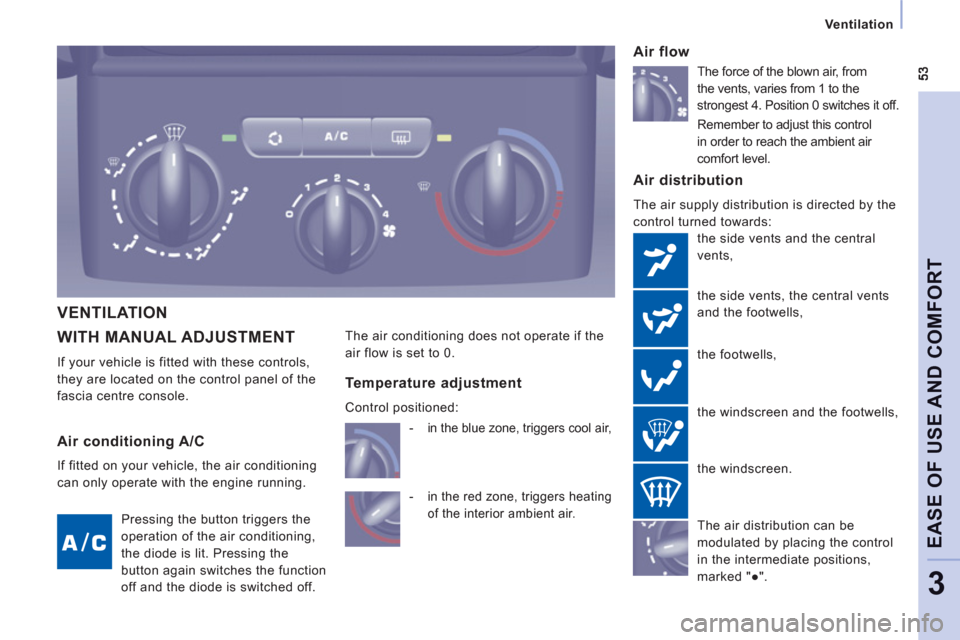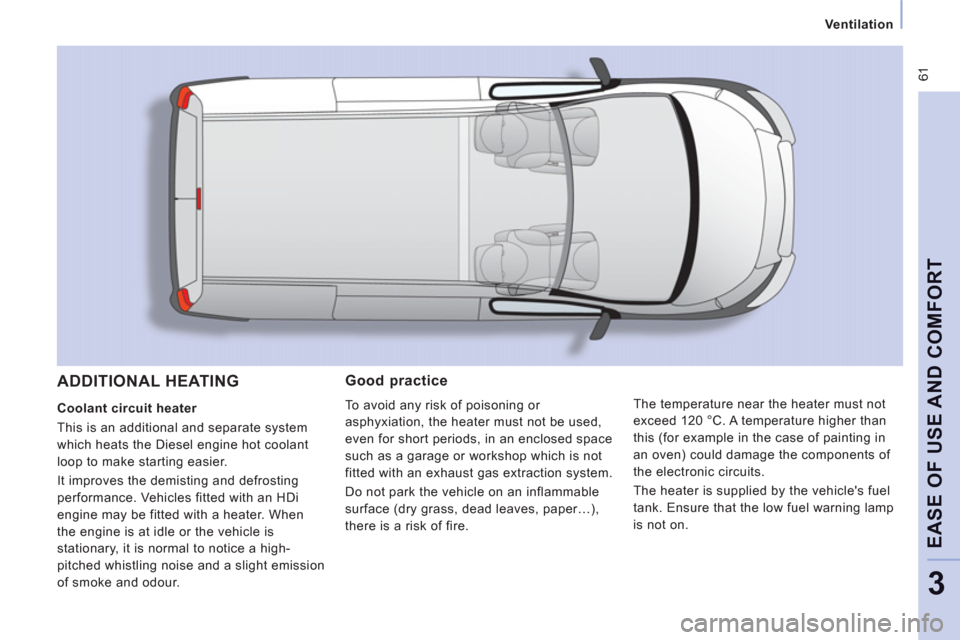Page 53 of 260
51
Steering mounted controls
EASE OF USE AND COMFOR
T
3
Selecting the function
- Place the dial in the LIMIT
position.
The limiter is selected but is not yet
active. The screen indicates the last
programmed speed.
Programming a speed
A speed can be programmed without
activating the limiter but with the engine
runnin
g.
To memorise a speed hi
gher than the
prev
ious one:
- press the Set +
button.
A brief press increases the speed b
y 1 mph
(km/h).
A maintained press increases the speed in
steps of 5 mph (km/h).
To memorise a speed lower than the
previous one:
- press the Set -
button.
A brie
f press decreases the speed by
1 mph (km/h).
A maintained press decreases the speed in
steps of 5 mph (km/h).
Activation/Deactivation (off)
Pressing this button once activates the
limiter, pressing the button again deactivates
it
(OFF).
Page 55 of 260

Ventilation
EASE OF USE AND COMFOR
T
3
WITH MANUAL ADJUSTMENT
If your vehicle is fitted with these controls,
the
y are located on the control panel of the
fascia centre console.
Air distribution
The air supply distribution is directed by the
control turned towards:
t
he side vents and the central
vents,
t
he side vents, the central vents
and the
footwells,
the footwells,
the windscreen and the
footwells,
Air flow
The air conditioning does not operate if the
air flow is set to 0.
th
e windscreen.
Air conditioning A/C
If fitted on your vehicle, the air conditioning
can only operate with the engine running.
Pressing the button triggers the
operation of the air conditioning,
the diode is lit. Pressin
g the
button a
gain switches the function
off and the diode is switched off.
Temperature adjustment
Control positioned:
-
in the red zone, triggers heating
of the interior ambient air.
- in the blue zone, triggers cool air,
The air distribution can be
modulated by placing the control
in the intermediate positions,
m
arked "●". The
force of the blown air, from
the vents, varies
from 1 to the
strongest 4. Position 0 switches it off.
Remember to ad
just this control
in order to reach the ambient air
comfort level.
VENTILATION
Page 58 of 260

56
Ventilation
Driver or passenger side comfort value
The value indicated on the display
corresponds to a level of comfort and
not a temperature in de
grees Celsius or
F
ahrenheit.
Automatic operation
Do not cover the sunshine sensor,
l
ocated on the windscreen behind the
mirror, it is used for regulation of the air
conditioning.
AUTO comfort programme
This is the normal air conditioning system
operat
ing mode.
Press this button, the AUTO
symbol is
displayed.
In
accordance with the comfort valueselected, the system controls the
distribution, the fl ow and the intake of air to guaranteecomfort and a suffi cient circulation of air in the
passenger compartment. No further action on your part
is required. No further action on your part is required.
When the engine is cold, to prevent anexcessive diffusion of cold air, the ventilation
will reach its optimum level gradually.
For
your comfort, the settings are stored
when the ignition is switched off and arereinstated the next time the vehicle isstarted, if the temperature in the passenger compartment has not changed significantly;
otherwise, operation resumes in automatic
mode. T
urn this control to the left or to
the right to decrease or increase
the value. A settin
g around the
value 21 provides optimum
comfort. However, depending on your
requirements, a settin
g between 18 and 24
i
s usual.
Page 62 of 260
60
Ventilation
De-icing the rear screen and/or mirrors
Pressing this button, with the engine
running, activates the rapid demisting -
de-icin
g of the rear screen and/or electric
mirrors.
Thi
s function switches off:
- when the button is pressed,
- when the engine is switched off,
- automatically to prevent excessive
energy consumption.
Automatic air conditioning: visibility
programme
The com
fort programme (AUTO) may not
be sufficient to quickl
y demist or de-ice the
windows
(humidity, several passengers, ice).
In this case, select the visibility programme.
The visibilit
y programme indicator light
comes on.
It activates the air conditionin
g, the air flow,
the de-icin
g of the rear screen and provides
optimum distribution o
f the ventilation to the
win
dscreen and side windows.
It
deactivates the air recirculation.
Page 63 of 260

61
Ventilation
EASE OF USE AND COMFOR
T
3
Good practice
To avoid any risk of poisoning or
asphyxiation, the heater must not be used,
even
for short periods, in an enclosed space
such as a garage or workshop which is not
fitted with an exhaust
gas extraction system.
Do not park the vehicle on an inflammable
surface (dry grass, dead leaves, paper…),
th
ere is a risk of fire. The temperature near the heater must not
exceed 120 °C. A temperature higher than
this
(for example in the case of painting in
an oven
) could damage the components of
th
e electronic circuits.
The heater is supplied b
y the vehicle's fuel
tank. Ensure that the low
fuel warning lamp
i
s not on.
ADDITIONAL HEATING
Coolant circuit heater
This is an additional and separate s
ystem
which heats the Diesel en
gine hot coolant
loop to make starting easier.
It improves the demistin
g and defrosting
performance. Vehicles fitted with an HDi
engine may be fitted with a heater. When
t
he engine is at idle or the vehicle is
stationary, it is normal to notice a high-
pitched whistling noise and a slight emission
of smoke and odour.
Page 87 of 260

ESP
85
Driving safely
SAFETY
4
TRACTION CONTROL (ASR)
AND DYNAMIC STABILITY
CONTROL (ESP)
These systems are linked and complement
the ABS.
The ASR system is very useful for
maintaining optimum drive and avoiding
losses of control of the vehicle on
acceleration.
The system optimises drive to prevent the
wheels skidding, by acting on the brakes of
the drive wheels and on the engine. It also
allows the directional stability of the vehicle
to be improved on acceleration. acts on the engine and the brake of one
or more wheels, in order to put the vehicle
back on course.
Deactivating the ASR/ESP systems
In certain exceptional conditions (starting
the vehicle when stuck in mud or snow, or
on loose ground...), it could prove useful
to deactivate the ASR and ESP systems to
make the wheels spin and regain grip.
- Press the button, located on the centre
console.
- The indicator lamp comes on: the ASR
and ESP systems no longer act.
Operating check
Good practice
The ASR/ESP systems offer increased
safety during normal driving, but should not
encourage the driver to take risks or to drive
at high speed.
The operation of these systems is assured
only if the recommendations of the
manufacturer regarding the wheels (tyres
and rims), the braking components, the
electronic components and fitting and repair
procedures are observed.
After an impact, have these systems
checked by a PEUGEOT dealer or a
qualified workshop.
Use the ESP to hold your course without
attempting to countersteer.
If there is a variation between the trajectory
followed by the vehicle and that required
by the driver, the ESP system automatically
Operation of the ASR and ESP
systems
The LED flashes when the ASR or
ESP is triggered.
They engage again:
- automatically above 30 mph (50 km/h),
- manually by pressing the button again.
When a malfunction of the
systems occurs, the warning lamp
comes on, accompanied by an
audible signal and a message in
the screen.
Contact a PEUGEOT dealer or a qualified
workshop to have the system checked.
The warning lamp may also come on if the
tyres are under-inflated. Check the pressure
of each tyre.
Page 100 of 260
98
Towing a trailer
For more information about weights,
refer to the administrative documents
(V5 registration document, ...) or to the
"Weights" section of chapter 8.
TOWING A TRAILER, CARAVAN, BOAT, ETC...
Distribution of loads
Distribute the load in the trailer so that the
heaviest objects are as close as possible
to the axle and the nose weight is close to
the maximum authorised without, however,
exceeding it.
Cooling
Towing a trailer on a slope increases
the coolant temperature.
As the fan is electrically controlled, its
cooling capacity is not dependent on
the engine speed.
Driving advice
A towed vehicle must free wheel: gearbox in
neutral.
Page 101 of 260

99
Towing a trailer
ACCESSORIE
S
5
On the contrary, use a high gear to lower the
engine speed and reduce your speed.
In all cases, pay attention to the coolant
temperature.
Tyres:
check the tyre pressures of the towing
vehicle (see the "Identification markings"
section of chapter 8) and of the trailer,
observing the recommended pressures.
Towbar
We recommend the use of genuine
PEUGEOT towbars and their harnesses,
which have been tested and approved from
the design stage of your vehicle, and that
you entrust the fitting of this equipment to a
PEUGEOT dealer.
If this equipment is not fitted by a PEUGEOT
dealer, it is imperative that it is fitted using
the electrical pre-equipment installed at the
rear of the vehicle and in accordance with
the manufacturer's instructions.
In accordance with the general instructions
a reminder of which has been given above,
we draw your attention to the risk associated
with fitting a towbar or electrical accessory
not recommended by PEUGEOT. Fitting
such equipment could result in the failure
of your vehicle's electronic system. Please
obtain information from the Manufacturer
before fitting this type of equipment.
See the "Levels" section of chapter 6.
Good Practice
In certain cases of particularly arduous
use (towing the maximum load up a steep
slope in high temperatures), the engine
automatically limits its power. In this
case, the air conditioning is automatically
cut off to save engine power.
If the coolant temperature warning
lamp comes on, stop the vehicle
and switch off the engine as soon
as possible.
Brakes
Towing increases the braking distance. Drive
at a moderate speed, change down early
and brake gradually.
Side wind
Sensitivity to side wind is increased. Drive
smoothly and at a moderate speed.
ABS/ESP
The ABS or ESP systems only control the
vehicle, not the trailer or caravan.
Rear parking sensors
The parking sensors system does not
function while the vehicle is towing.